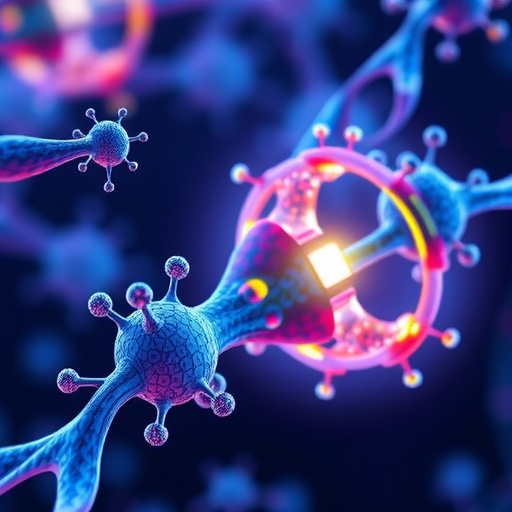The field of cancer research is constantly evolving, driven by the pursuit of a deeper understanding of the molecular mechanisms underlying tumorigenesis. A recent study led by Wang, Zhao, and Xin explores the enigmatic world of RING-type ubiquitin E3 ligases, particularly focusing on the RING-UIM (Ubiquitin Interacting Motif) subclass. Their research, which promises to transform our understanding of cancer biology, provides a detailed examination of how these ligases function in cellular regulation, making them a focal point in therapeutic innovation.
Ubiquitin-mediated proteasomal degradation serves as a critical pathway for maintaining cellular homeostasis. RING E3 ligases play a pivotal role in this process, acting as intermediaries that facilitate the transfer of ubiquitin molecules to target proteins. This ubiquitination often marks the substrates for degradation or alters their activity, resulting in significant changes to cellular signaling pathways. The RING-UIM E3 ligases, with their unique domain architecture, have raised questions regarding their specific roles in oncogenic processes, making their study essential for understanding cancer dynamics.
The RING-UIM E3 ligases are characterized by their RING finger domain and the presence of UIMs, which enable them to bind and manipulate ubiquitin-conjugated substrates effectively. Wang et al. delve into the mechanistic insights of these ligases, shedding light on how they link the ubiquitylation of proteins to fundamental cellular processes such as proliferation, apoptosis, and DNA repair. By dissecting these mechanisms, the authors highlight the potential of targeting RING-UIM ligases in cancer therapy, presenting a new frontier in the development of cancer treatments.
As cancer cells often exploit the ubiquitin-proteasome system to evade growth control, understanding the role of RING-UIM E3 ligases in this context opens new avenues for therapeutic interventions. The study reveals how certain ligases can promote tumorigenesis by degrading tumor suppressors or stabilizing oncogenic proteins. This dualistic nature of E3 ligases complicates their targeting; therapeutic strategies must carefully consider the context-dependent activities of these enzymes to avoid unintended consequences in patients.
One of the most compelling aspects of the research by Wang and colleagues is the association of RING-UIM E3 ligases with various cancer types. The team presents data suggesting that dysregulation of these ligases correlates strongly with aggressive cancer phenotypes. By integrating genomic, proteomic, and bioinformatic analyses, they provide compelling evidence that aberrant expression of specific RING-UIM ligases is often an early event in tumorigenesis. This affiliation indicates that they could serve as useful biomarkers for cancer prognosis or response to therapy.
Moreover, the research underscores the potential for RING-UIM ligases to be targeted by small-molecule inhibitors. The modular nature of these ligases makes them attractive targets for the development of drugs that could disrupt their activity. Wang et al. further discuss the progress in high-throughput screening methods aimed at identifying novel inhibitors of RING-UIM E3 ligases. The success of such endeavors could lead to innovative treatments that specifically enhance the degradation of oncogenic drivers in cancer cells, thereby limiting tumor growth.
Another critical point raised in the article revolves around the interaction of RING-UIM ligases with other cellular machinery, such as kinases and phosphatases. This crosstalk between different signaling pathways emphasizes the complexity of cellular regulation in cancer. The study highlights how the communication between E3 ligases and other cellular proteins can significantly reshape the landscape of signaling pathways related to cell cycle progression and apoptosis. Understanding these interactions is crucial in identifying synergistic treatment strategies that could enhance the efficacy of existing therapies.
The implications of the findings presented by Wang and his team extend beyond basic cancer biology. The identification of specific RING-UIM E3 ligases involved in drug resistance mechanisms offers new perspectives on overcoming therapeutic challenges. By elucidating how these ligases contribute to the maintenance of cancer stem cell populations, researchers can begin to formulate strategies aimed at eradicating these resilient cell subsets, which are often responsible for treatment failure and tumor recurrence.
In addition to potential therapeutic applications, the investigative work surrounding RING-UIM E3 ligases raises important questions regarding the ethical dimensions of cancer research. As with any burgeoning field, there is a responsibility to navigate the delicate landscape of molecular targeting with caution. The consequences of targeting specific E3 ligases in cancer treatment could have wider implications, potentially affecting normal physiological processes. These considerations highlight the importance of translating findings from bench to bedside in a thoughtful manner.
The excitement surrounding the discovery of the roles played by RING-UIM E3 ligases in cancer research calls for a collaborative effort across disciplines. By integrating data from pharmacology, molecular biology, and clinical research, scientists can foster an environment conducive to translating these findings into clinical applications. Collaborative models involving academia, industry, and regulatory agencies will be pivotal in advancing the development of RING-UIM ligase inhibitors while ensuring patient safety is prioritized.
As the authors conclude, the journey from understanding the mechanistic details of RING-UIM E3 ligases to their application in cancer therapy is just beginning. The road ahead is paved with both challenges and opportunities. Stakeholders in cancer research must continue to pursue this promising line of inquiry with enthusiasm and caution, aiming to bridge the gap between basic research and therapeutic innovation for improved patient outcomes.
Ultimately, the study by Wang, Zhao, and Xin reflects a significant leap in comprehending the multifaceted roles of RING-UIM E3 ligases. By integrating molecular insights with clinical relevance, they provide a comprehensive understanding of how these entities are intertwined with cancer dynamics. Their research underscores the transformative potential of RING-UIM E3 ligases in shaping the future landscape of cancer therapies, pointing to a dynamic horizon where scientific enlightenment leads to tangible benefits for patients.
Subject of Research: RING-UIM E3 ligases and their impact on cancer research.
Article Title: The enigma of the RING-UIM E3 ligases: its transformative impact on cancer research.
Article References: Wang, Y., Zhao, Y., Xin, Q. et al. The enigma of the RING-UIM E3 ligases: its transformative impact on cancer research. J Transl Med 23, 1084 (2025). https://doi.org/10.1186/s12967-025-07194-8
Image Credits: AI Generated
DOI: 10.1186/s12967-025-07194-8
Keywords: RING-UIM E3 ligases, cancer research, ubiquitin, proteasomal degradation, molecular biology.




